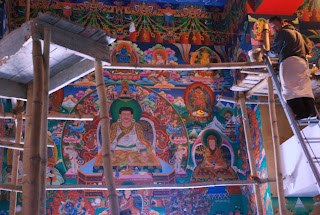Sunday, March 27, 2011
Fire that Turned into Water
Gerard found an interesting sounding place, 25 kms off the main road. The only information he could get from the Internet was that it was a Tibetan enclave. So we thought we’d go and spend a day or so. The bus ride from Mandi through the valley up the mountainside heightened our expectation. Rewalsar is a small town beside a lake, made up mostly of Tibetans, but there’s also a large Sikh gurdwara and a Shiva temple. Walking down the main street looking for a guesthouse, a friendly Tibetan merchant greeted us and recommended that we stay in one of the four monasteries that dominate the town. Taking his advice, we took a large clean room overlooking the monastery and lake - and a gigantic Buddhist statue on the hillside.
The typical Tibetan chanting with horns and gongs was sounding in the courtyard. Gerard commented, “This sounds like one of the avante-garde jazz bands I like!” In the late afternoon, we walked down to the lake as the sun disappeared behind the hills. We both agreed that maybe Reselwar deserved more than just a day or so.
After breakfast the merchant advised we go up to the statue of Guru Padmasambava Rinpoche, called Guru Rinpoche for short. It’s newly constructed and in the building beneath it elaborate tonga style painting is in progress on the walls and ceiling. A group of young Bhutanese men are painstakingly executing intricate scenes from the life, we believe, of Guru Rinpoche. It’s hard to get the full story because people speak very little English. It appears that one man draws the scenes (from memory) while others follow behind doing the inpainting (once again from memory). Gerard looked around for plans or photographs - anything that would guide the artists…but there was nothing. Later we were told that these artists have been highly trained from the age of eight, and they don’t need any reference material. There were neon colours of every description. We both felt that it was a rare opportunity to see this work being executed.
Guru Rinpoche came from Afghanistan to Nepal and then to Rewalsar in the district of Mandi. He’s mostly known for being the person responsible for bringing Buddhism to the Tibetans who were previously practicing a shaman practice called Bon. At the top of a steep hill above the town, Guru Rinpoche meditated for many years in a cave. Walking in the nearby forest one day, he met the King of Mandi’s daughter and they connected spiritually. The local people were jealous unable to believe it was a pure relationship and told the king.. Annoyed the king sent soldiers who pulled Guru Rinpoche down from his cave and set fire to the forest to burn him alive. The Guru stayed in meditation and turned into a lotus - and the fire turned into water.. It is now called the Lotus Lake. But the way the story goes depends on who you ask, and there’s little information on the Internet to verify.
One morning, we went up to the cave where Guru Rinpoche meditated. Deep in its interior is a large Buddha statue. The silence in the cave was nearly deafening. And of course the whole hilltop was covered with fluttering prayer flags. From the hilltop we noticed an interesting looking building overlooking the lake that was clearly not Buddhist. So the next day we investigated. It turned out to be a large Sikh gurdwara. A young Sikh man told us that this was the spot where Guru Gobind Singh (the last Sikh Guru) met with the Hindus to strategize to fight the infamous Mogul emperor, Arjungazeb. The atmosphere was very peaceful as we sat drinking chai from the langar and conversing with the young Sikh in the late afternoon.
One evening we were trying to meditate with the sound of loud drums and horns right outside our window. Finally I got up and looked down into the courtyard where a large group of people were encircling a line of dancing women in full regalia. The story was that some people were visiting from Ladakh and the locals were so pleased to see the visitors that they danced for them. Later, after we’d gone to sleep, we were woken by them dancing again - as if they could not contain their joy.
Rewalsar is sacred to Hindus, Buddhists and Sikhs. A number of westerners practicing Buddhism are here, dressed in the traditional red robes, but it is still largely undiscovered.
Among the very few tourists is a Frenchman from Provence called Frederic. He’s been here for the past six weeks and both of us enjoy talking with him. One evening he showed us a lovely walk through the green terraced countryside to a small Shiva temple. We sat for a long time taking in the view.
Reselwar is one of those places attractive in so many different ways that you wonder if it will exist after you leave…and if you were to return, would it have completely changed? Part of the charm is finding this place, and the rest is the people who mostly still seem rooted in the traditional life style and are not complicated by the stresses and strains of the west. The Tibetans walk up and down the street with their spinning prayer wheel in one hand and prayer beads in the other; their mantra on their lips. They don’t seem to be interrupted by our presence; at the same time they’ve very welcoming, and the women seem especially friendly toward me! The seeming ease between the three communities is also a welcome contrast from the communal rioting that delays our trains in India and the continued agitation in the Middle East
Subscribe to:
Post Comments (Atom)










No comments:
Post a Comment